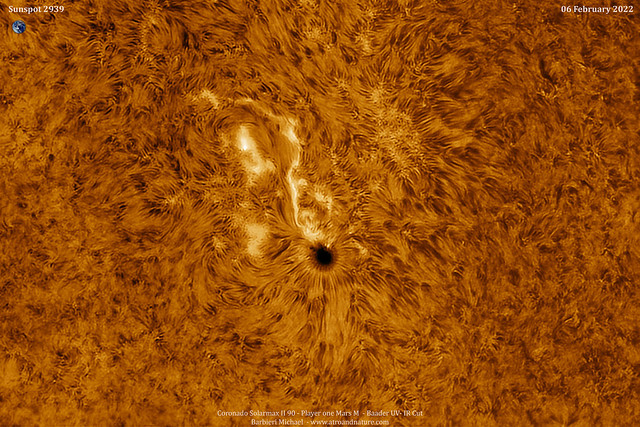Sun H-alpha 02-2022
É da un po' che non aggiornavo il sito con alcune foto ma, a mia discolpa, posso dire in tutta serenità che il seeing negli ultimi mesi è stato veramente disastroso. Per lo più il periodo invernale non è proprio la stagione ideale per fare qualche foto macro. Mi sono così buttato sull’unica cosa che potevo fotografare: il sole. Grazie all’Associazione astrofili Mantovani (associazione di cui faccio parte. Veniteci a trovare in osservatorio: guardate nella sezione amici del sito per i contatti) sono entrato in possesso di un telescopio Coronado Solarmax 90 di proprietà dell’associazione. Questo strumento permette di vedere e fotografare la cromosfera solare con tanto di protuberanze. Al contempo ho potuto testare la mia nuova camera Player one Mars-M (ideale per fotografare il sole grazie al tilt integrato). Dopo alcuni giorni di riprese ecco alcune considerazioni che ho maturato rispetto alla strumentazione e al processing. Guardare all’interno di un telescopio solare è veramente pazzesco! Vedere le protuberanze che si elevano dal sole per centinaia di migliaia di km è impressionante e ti fa capire quale sia la potenza della nostra stella. Fotografarci è altrettanto eccezionale anche se in un primo momento (se non si è esperti) un po' frustrante. Intanto c’è il problema dei riflessi e la luce sullo schermo del pc che non ti permette di mettere a fuoco correttamente. Ancor prima di fotografare fate un piacere alla vostra vista: fatevi un paraluce per lo schermo, è molto semplice e vi servono pochi euro. Io personalmente, avendo già un telo Geoptik uso quello coprendo lo schermo. Risolto il problema del riflesso ci sono due problemi, se così vogliamo chiamarli, nel momento della ripresa. Sto parlando dei flat solari e della gestione della luminosità tra la cromosfera solare e le protuberanze. I flat bisogna farli altrimenti in foto la cromosfera assume una disomogeneità nella luminosità di fondo. C’è una funzione specifica di firecapture, ma sinceramente devo ancora capire come ottenere dei buoni flat. Il secondo problema, come anticipato, è la gestione della luminosità. Per nulla facile avere una giusta esposizione tra cromosfera e protuberanze. Ho trovato alcuni miglioramenti con l’utilizzo del gamma in firecpature. In ogni caso c’è ancora margine di miglioramento. Esposti questi due problemi, risolvibilissimi con un po' di esperienza in più, posso però dire che fotografare il sole è veramente eccitante soprattutto perché ogni giorno è diverse. Addirittura le protuberanze possono modificarsi in pochi minuti. Condivido con voi alcune foto realizzate in questi giorni. Un saluto a tutti.
ENIt has been a long time since I updated the site with some photos but, in my defense, I can say in all serenity that the seeing in recent months has been truly disastrous. Furthermore, winter is not exactly the ideal season to take some macro photos. So I threw myself on the only thing I could photograph: the sun. Thanks to the Mantovani amateurs association (an association to which I belong. Come and visit us at the observatory: look in the friends section of the site for contacts) I have come into possession of a Coronado Solarmax 90 telescope owned by the association. This telescope allows you to see and photograph the solar chromosphere complete with protuberances. At the same time I was able to test my new Player one Mars-M camera (ideal for photographing the sun thanks to the integrated tilt). After a few days of shooting here are some considerations that I have gained with respect to the instrumentation and processing. Looking inside a solar telescope is truly insane! observing the protuberances that rise from the sun for hundreds of thousands of km is impressive and makes you understand what the power of our star is. Photographing us is equally exceptional even if at first (if you are not an expert) a little frustrating. There is the problem of reflections and the light on the PC screen that does not allow you to focus correctly. Give your eyes a pleasure: make a lens hood for the screen, it's very simple and you only need a few euros. I cover the screen with a Geoptik sheet. Fixed the reflection problem there are two problems. I'm talking about the solar flats and the management of the brightness between the solar chromosphere and the protuberances. The flats must be done otherwise the chromosphere assumes an inhomogeneity in the background brightness. There is a specific feature of firecapture, but honestly I have yet to figure out how to get flat coupons. The second problem is the management of brightness. It is not easy to have the right exposure between the chromosphere and the protuberances. I found an improvement with using gamma in firecpature. In any case, there is still room for improvement. Having exposed these two problems, which can be solved with a little experience, I can however say that photographing the sun is really exciting especially because every day is different. The bumps can change in minutes. I share with you some photos taken in these days. Hello everybody.
Setup
- Telescope: Solarmax II 90 mm
- Camera: Player one Mars-M
- Mount: SW EQ6 PRo
- Filter: Baader Uv-Ir cut



